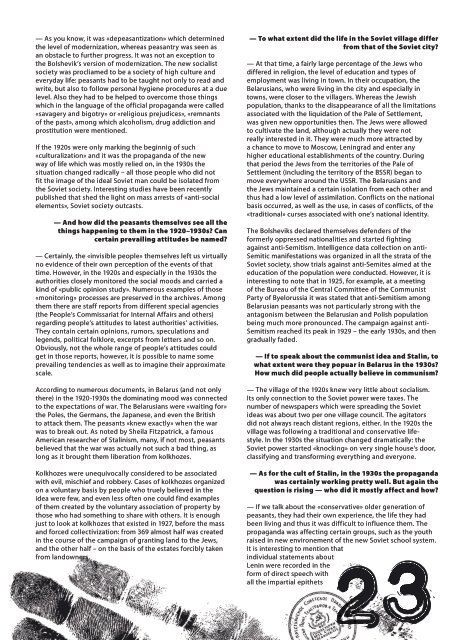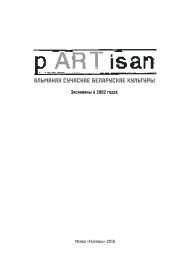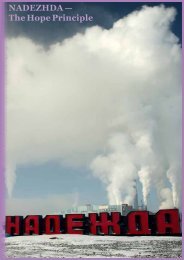pARTisan_32
You also want an ePaper? Increase the reach of your titles
YUMPU automatically turns print PDFs into web optimized ePapers that Google loves.
— As you know, it was «depeasantization» which determined<br />
the level of modernization, whereas peasantry was seen as<br />
an obstacle to further progress. It was not an exception to<br />
the Bolshevik’s version of modernization. The new socialist<br />
society was procliamed to be a society of high culture and<br />
everyday life: peasants had to be taught not only to read and<br />
write, but also to follow personal hygiene procedures at a due<br />
level. Also they had to be helped to overcome those things<br />
which in the language of the official propaganda were called<br />
«savagery and bigotry» or «religious prejudices», «remnants<br />
of the past», among which alcoholism, drug addiction and<br />
prostitution were mentioned.<br />
If the 1920s were only marking the beginnig of such<br />
«culturalization» and it was the propaganda of the new<br />
way of life which was mostly relied on, in the 1930s the<br />
situation changed radically – all those people who did not<br />
fit the image of the ideal Soviet man could be isolated from<br />
the Soviet society. Interesting studies have been recently<br />
published that shed the light on mass arrests of «anti-social<br />
elements», Soviet society outcasts.<br />
— And how did the peasants themselves see all the<br />
things happening to them in the 1920–1930s? Can<br />
certain prevailing attitudes be named?<br />
— Certainly, the «invisible people» themselves left us virtually<br />
no evidence of their own perception of the events of that<br />
time. However, in the 1920s and especially in the 1930s the<br />
authorities closely monitored the social moods and carried a<br />
kind of «public opinion study». Numerous examples of those<br />
«monitoring» processes are preserved in the archives. Among<br />
them there are staff reports from different special agencies<br />
(the People’s Commissariat for Internal Affairs and others)<br />
regarding people’s attitudes to latest authorities’ activities.<br />
They contain certain opinions, rumors, speculations and<br />
legends, political folklore, excerpts from letters and so on.<br />
Obviously, not the whole range of people’s attitudes could<br />
get in those reports, however, it is possible to name some<br />
prevailing tendencies as well as to imagine their approximate<br />
scale.<br />
According to numerous documents, in Belarus (and not only<br />
there) in the 1920-1930s the dominating mood was connected<br />
to the expectations of war. The Belarusians were «waiting for»<br />
the Poles, the Germans, the Japanese, and even the British<br />
to attack them. The peasants «knew exactly» when the war<br />
was to break out. As noted by Sheila Fitzpatrick, a famous<br />
American researcher of Stalinism, many, if not most, peasants<br />
believed that the war was actually not such a bad thing, as<br />
long as it brought them liberation from kolkhozes.<br />
Kolkhozes were unequivocally considered to be associated<br />
with evil, mischief and robbery. Cases of kolkhozes organized<br />
on a voluntary basis by people who truely believed in the<br />
idea were few, and even less often one could find examples<br />
of them created by the voluntary association of property by<br />
those who had something to share with others. It is enough<br />
just to look at kolkhozes that existed in 1927, before the mass<br />
and forced collectivization: from 369 almost half was created<br />
in the course of the campaign of granting land to the Jews,<br />
and the other half – on the basis of the estates forcibly taken<br />
from landowners.<br />
— To what extent did the life in the Soviet village differ<br />
from that of the Soviet city?<br />
— At that time, a fairly large percentage of the Jews who<br />
differed in religion, the level of education and types of<br />
employment was living in town. In their occupation, the<br />
Belarusians, who were living in the city and especially in<br />
towns, were closer to the villagers. Whereas the Jewish<br />
population, thanks to the disappearance of all the limitations<br />
associated with the liquidation of the Pale of Settlement,<br />
was given new opportunities then. The Jews were allowed<br />
to cultivate the land, although actually they were not<br />
really interested in it. They were much more attracted by<br />
a chance to move to Moscow, Leningrad and enter any<br />
higher educational establishments of the country. During<br />
that period the Jews from the territories of the Pale of<br />
Settlement (including the territory of the BSSR) began to<br />
move everywhere around the USSR. The Belarusians and<br />
the Jews maintained a certain isolation from each other and<br />
thus had a low level of assimilation. Conflicts on the national<br />
basis occurred, as well as the use, in cases of conflicts, of the<br />
«traditional» curses associated with one’s national identity.<br />
The Bolsheviks declared themselves defenders of the<br />
formerly oppressed nationalities and started fighting<br />
against anti-Semitism. Intelligence data collection on anti-<br />
Semitic manifestations was organized in all the strata of the<br />
Soviet society, show trials against anti-Semites aimed at the<br />
education of the population were conducted. However, it is<br />
interesting to note that in 1925, for example, at a meeting<br />
of the Bureau of the Central Committee of the Communist<br />
Party of Byelorussia it was stated that anti-Semitism among<br />
Belarusian peasants was not particularly strong with the<br />
antagonism between the Belarusian and Polish population<br />
being much more pronounced. The campaign against anti-<br />
Semitism reached its peak in 1929 – the early 1930s, and then<br />
gradually faded.<br />
— If to speak about the communist idea and Stalin, to<br />
what extent were they popuar in Belarus in the 1930s?<br />
How much did people actually believe in communism?<br />
— The village of the 1920s knew very little about socialism.<br />
Its only connection to the Soviet power were taxes. The<br />
number of newspapers which were spreading the Soviet<br />
ideas was about two per one village council. The agitators<br />
did not always reach distant regions, either. In the 1920s the<br />
village was following a traditional and conservative lifestyle.<br />
In the 1930s the situation changed dramatically: the<br />
Soviet power started «knocking» on very single house’s door,<br />
classifying and transforming everything and everyone.<br />
— As for the cult of Stalin, in the 1930s the propaganda<br />
was certainly working pretty well. But again the<br />
question is rising — who did it mostly affect and how?<br />
— If we talk about the «conservative» older generation of<br />
peasants, they had their own experience, the life they had<br />
been living and thus it was difficult to influence them. The<br />
propaganda was affecting certain groups, such as the youth<br />
raised in new environement of the new Soviet school system.<br />
It is interesting to mention that<br />
individual statements about<br />
Lenin were recorded in the<br />
form of direct speech with<br />
23<br />
all the impartial epithets





